Jiashi Feng
NUS
Puppeteer: Rig and Animate Your 3D Models
Aug 14, 2025



Abstract:Modern interactive applications increasingly demand dynamic 3D content, yet the transformation of static 3D models into animated assets constitutes a significant bottleneck in content creation pipelines. While recent advances in generative AI have revolutionized static 3D model creation, rigging and animation continue to depend heavily on expert intervention. We present Puppeteer, a comprehensive framework that addresses both automatic rigging and animation for diverse 3D objects. Our system first predicts plausible skeletal structures via an auto-regressive transformer that introduces a joint-based tokenization strategy for compact representation and a hierarchical ordering methodology with stochastic perturbation that enhances bidirectional learning capabilities. It then infers skinning weights via an attention-based architecture incorporating topology-aware joint attention that explicitly encodes inter-joint relationships based on skeletal graph distances. Finally, we complement these rigging advances with a differentiable optimization-based animation pipeline that generates stable, high-fidelity animations while being computationally more efficient than existing approaches. Extensive evaluations across multiple benchmarks demonstrate that our method significantly outperforms state-of-the-art techniques in both skeletal prediction accuracy and skinning quality. The system robustly processes diverse 3D content, ranging from professionally designed game assets to AI-generated shapes, producing temporally coherent animations that eliminate the jittering issues common in existing methods.
Traceable Evidence Enhanced Visual Grounded Reasoning: Evaluation and Methodology
Jul 10, 2025Abstract:Models like OpenAI-o3 pioneer visual grounded reasoning by dynamically referencing visual regions, just like human "thinking with images". However, no benchmark exists to evaluate these capabilities holistically. To bridge this gap, we propose TreeBench (Traceable Evidence Evaluation Benchmark), a diagnostic benchmark built on three principles: (1) focused visual perception of subtle targets in complex scenes, (2) traceable evidence via bounding box evaluation, and (3) second-order reasoning to test object interactions and spatial hierarchies beyond simple object localization. Prioritizing images with dense objects, we initially sample 1K high-quality images from SA-1B, and incorporate eight LMM experts to manually annotate questions, candidate options, and answers for each image. After three stages of quality control, TreeBench consists of 405 challenging visual question-answering pairs, even the most advanced models struggle with this benchmark, where none of them reach 60% accuracy, e.g., OpenAI-o3 scores only 54.87. Furthermore, we introduce TreeVGR (Traceable Evidence Enhanced Visual Grounded Reasoning), a training paradigm to supervise localization and reasoning jointly with reinforcement learning, enabling accurate localizations and explainable reasoning pathways. Initialized from Qwen2.5-VL-7B, it improves V* Bench (+16.8), MME-RealWorld (+12.6), and TreeBench (+13.4), proving traceability is key to advancing vision-grounded reasoning. The code is available at https://github.com/Haochen-Wang409/TreeVGR.
Seed1.5-VL Technical Report
May 11, 2025Abstract:We present Seed1.5-VL, a vision-language foundation model designed to advance general-purpose multimodal understanding and reasoning. Seed1.5-VL is composed with a 532M-parameter vision encoder and a Mixture-of-Experts (MoE) LLM of 20B active parameters. Despite its relatively compact architecture, it delivers strong performance across a wide spectrum of public VLM benchmarks and internal evaluation suites, achieving the state-of-the-art performance on 38 out of 60 public benchmarks. Moreover, in agent-centric tasks such as GUI control and gameplay, Seed1.5-VL outperforms leading multimodal systems, including OpenAI CUA and Claude 3.7. Beyond visual and video understanding, it also demonstrates strong reasoning abilities, making it particularly effective for multimodal reasoning challenges such as visual puzzles. We believe these capabilities will empower broader applications across diverse tasks. In this report, we mainly provide a comprehensive review of our experiences in building Seed1.5-VL across model design, data construction, and training at various stages, hoping that this report can inspire further research. Seed1.5-VL is now accessible at https://www.volcengine.com/ (Volcano Engine Model ID: doubao-1-5-thinking-vision-pro-250428)
Pixel-SAIL: Single Transformer For Pixel-Grounded Understanding
Apr 14, 2025Abstract:Multimodal Large Language Models (MLLMs) achieve remarkable performance for fine-grained pixel-level understanding tasks. However, all the works rely heavily on extra components, such as vision encoder (CLIP), segmentation experts, leading to high system complexity and limiting model scaling. In this work, our goal is to explore a highly simplified MLLM without introducing extra components. Our work is motivated by the recent works on Single trAnsformer as a unified vIsion-Language Model (SAIL) design, where these works jointly learn vision tokens and text tokens in transformers. We present Pixel-SAIL, a single transformer for pixel-wise MLLM tasks. In particular, we present three technical improvements on the plain baseline. First, we design a learnable upsampling module to refine visual token features. Secondly, we propose a novel visual prompt injection strategy to enable the single transformer to understand visual prompt inputs and benefit from the early fusion of visual prompt embeddings and vision tokens. Thirdly, we introduce a vision expert distillation strategy to efficiently enhance the single transformer's fine-grained feature extraction capability. In addition, we have collected a comprehensive pixel understanding benchmark (PerBench), using a manual check. It includes three tasks: detailed object description, visual prompt-based question answering, and visual-text referring segmentation. Extensive experiments on four referring segmentation benchmarks, one visual prompt benchmark, and our PerBench show that our Pixel-SAIL achieves comparable or even better results with a much simpler pipeline. Code and model will be released at https://github.com/magic-research/Sa2VA.
The Scalability of Simplicity: Empirical Analysis of Vision-Language Learning with a Single Transformer
Apr 14, 2025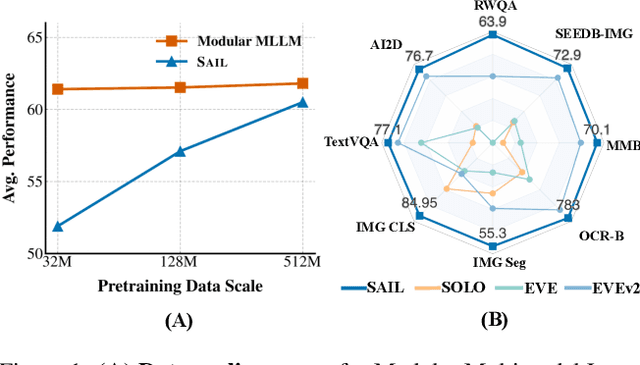
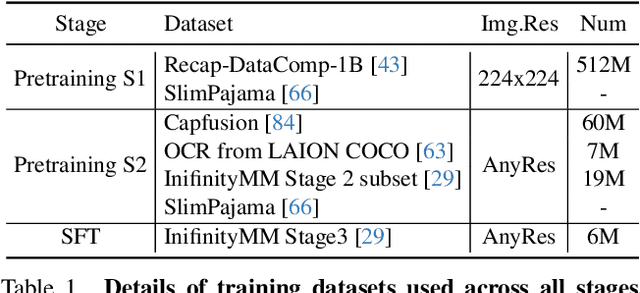
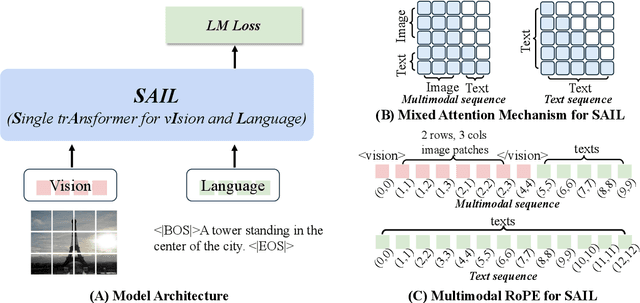
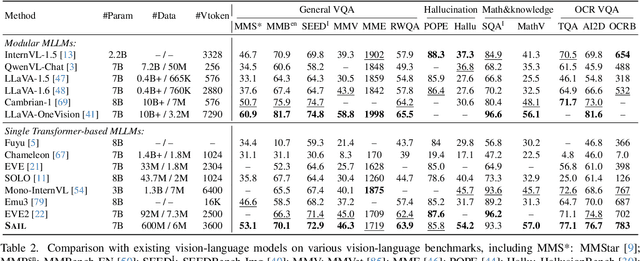
Abstract:This paper introduces SAIL, a single transformer unified multimodal large language model (MLLM) that integrates raw pixel encoding and language decoding within a singular architecture. Unlike existing modular MLLMs, which rely on a pre-trained vision transformer (ViT), SAIL eliminates the need for a separate vision encoder, presenting a more minimalist architecture design. Instead of introducing novel architectural components, SAIL adapts mix-attention mechanisms and multimodal positional encodings to better align with the distinct characteristics of visual and textual modalities. We systematically compare SAIL's properties-including scalability, cross-modal information flow patterns, and visual representation capabilities-with those of modular MLLMs. By scaling both training data and model size, SAIL achieves performance comparable to modular MLLMs. Notably, the removal of pretrained ViT components enhances SAIL's scalability and results in significantly different cross-modal information flow patterns. Moreover, SAIL demonstrates strong visual representation capabilities, achieving results on par with ViT-22B in vision tasks such as semantic segmentation. Code and models are available at https://github.com/bytedance/SAIL.
Seaweed-7B: Cost-Effective Training of Video Generation Foundation Model
Apr 11, 2025Abstract:This technical report presents a cost-efficient strategy for training a video generation foundation model. We present a mid-sized research model with approximately 7 billion parameters (7B) called Seaweed-7B trained from scratch using 665,000 H100 GPU hours. Despite being trained with moderate computational resources, Seaweed-7B demonstrates highly competitive performance compared to contemporary video generation models of much larger size. Design choices are especially crucial in a resource-constrained setting. This technical report highlights the key design decisions that enhance the performance of the medium-sized diffusion model. Empirically, we make two observations: (1) Seaweed-7B achieves performance comparable to, or even surpasses, larger models trained on substantially greater GPU resources, and (2) our model, which exhibits strong generalization ability, can be effectively adapted across a wide range of downstream applications either by lightweight fine-tuning or continue training. See the project page at https://seaweed.video/
GigaTok: Scaling Visual Tokenizers to 3 Billion Parameters for Autoregressive Image Generation
Apr 11, 2025Abstract:In autoregressive (AR) image generation, visual tokenizers compress images into compact discrete latent tokens, enabling efficient training of downstream autoregressive models for visual generation via next-token prediction. While scaling visual tokenizers improves image reconstruction quality, it often degrades downstream generation quality -- a challenge not adequately addressed in existing literature. To address this, we introduce GigaTok, the first approach to simultaneously improve image reconstruction, generation, and representation learning when scaling visual tokenizers. We identify the growing complexity of latent space as the key factor behind the reconstruction vs. generation dilemma. To mitigate this, we propose semantic regularization, which aligns tokenizer features with semantically consistent features from a pre-trained visual encoder. This constraint prevents excessive latent space complexity during scaling, yielding consistent improvements in both reconstruction and downstream autoregressive generation. Building on semantic regularization, we explore three key practices for scaling tokenizers:(1) using 1D tokenizers for better scalability, (2) prioritizing decoder scaling when expanding both encoder and decoder, and (3) employing entropy loss to stabilize training for billion-scale tokenizers. By scaling to $\bf{3 \space billion}$ parameters, GigaTok achieves state-of-the-art performance in reconstruction, downstream AR generation, and downstream AR representation quality.
4th PVUW MeViS 3rd Place Report: Sa2VA
Apr 01, 2025Abstract:Referring video object segmentation (RVOS) is a challenging task that requires the model to segment the object in a video given the language description. MeViS is a recently proposed dataset that contains motion expressions of the target objects, leading to a challenging benchmark, compared with existing RVOS benchmarks. On the other hand, for referring expression tasks, a new trend is to adopt multi-modal large language model (MLLM) to achieve better image and text alignment. In this report, we show that with a simple modification to the test time inference method on stronger MLLMs, we can lead to stronger results on MeVIS. In particular, we adopt the recent method Sa2VA, a unified model for dense grounded understanding of both images and videos. By enlarging the scope of key frames, without any further training, we can achieve the 3rd place in the 4th PVUW workshop.
Bridging Continuous and Discrete Tokens for Autoregressive Visual Generation
Mar 20, 2025Abstract:Autoregressive visual generation models typically rely on tokenizers to compress images into tokens that can be predicted sequentially. A fundamental dilemma exists in token representation: discrete tokens enable straightforward modeling with standard cross-entropy loss, but suffer from information loss and tokenizer training instability; continuous tokens better preserve visual details, but require complex distribution modeling, complicating the generation pipeline. In this paper, we propose TokenBridge, which bridges this gap by maintaining the strong representation capacity of continuous tokens while preserving the modeling simplicity of discrete tokens. To achieve this, we decouple discretization from the tokenizer training process through post-training quantization that directly obtains discrete tokens from continuous representations. Specifically, we introduce a dimension-wise quantization strategy that independently discretizes each feature dimension, paired with a lightweight autoregressive prediction mechanism that efficiently model the resulting large token space. Extensive experiments show that our approach achieves reconstruction and generation quality on par with continuous methods while using standard categorical prediction. This work demonstrates that bridging discrete and continuous paradigms can effectively harness the strengths of both approaches, providing a promising direction for high-quality visual generation with simple autoregressive modeling. Project page: https://yuqingwang1029.github.io/TokenBridge.
MagicArticulate: Make Your 3D Models Articulation-Ready
Feb 18, 2025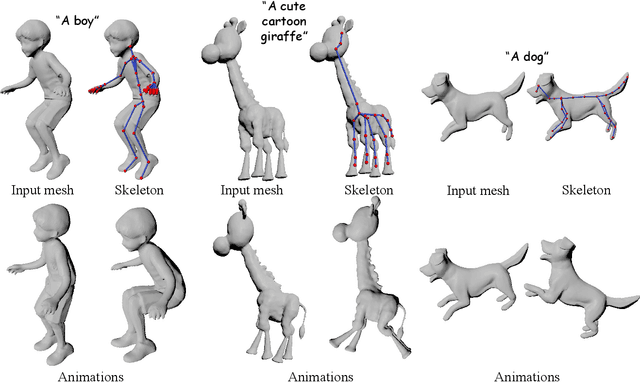
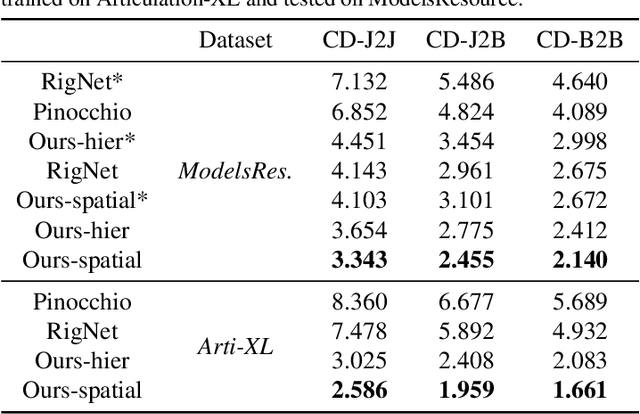
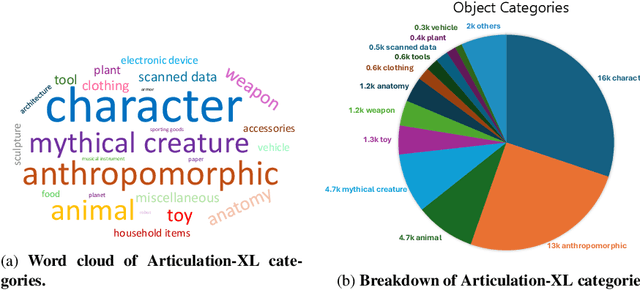
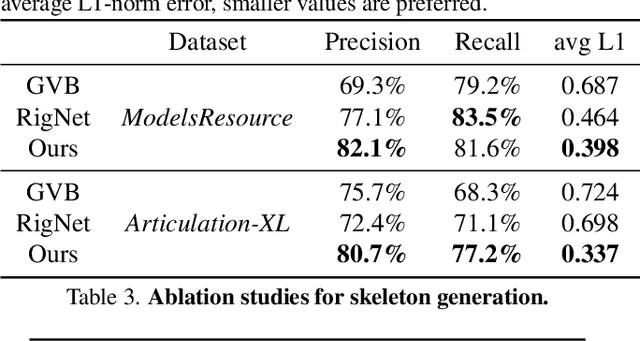
Abstract:With the explosive growth of 3D content creation, there is an increasing demand for automatically converting static 3D models into articulation-ready versions that support realistic animation. Traditional approaches rely heavily on manual annotation, which is both time-consuming and labor-intensive. Moreover, the lack of large-scale benchmarks has hindered the development of learning-based solutions. In this work, we present MagicArticulate, an effective framework that automatically transforms static 3D models into articulation-ready assets. Our key contributions are threefold. First, we introduce Articulation-XL, a large-scale benchmark containing over 33k 3D models with high-quality articulation annotations, carefully curated from Objaverse-XL. Second, we propose a novel skeleton generation method that formulates the task as a sequence modeling problem, leveraging an auto-regressive transformer to naturally handle varying numbers of bones or joints within skeletons and their inherent dependencies across different 3D models. Third, we predict skinning weights using a functional diffusion process that incorporates volumetric geodesic distance priors between vertices and joints. Extensive experiments demonstrate that MagicArticulate significantly outperforms existing methods across diverse object categories, achieving high-quality articulation that enables realistic animation. Project page: https://chaoyuesong.github.io/MagicArticulate.
 Add to Chrome
Add to Chrome Add to Firefox
Add to Firefox Add to Edge
Add to Edge